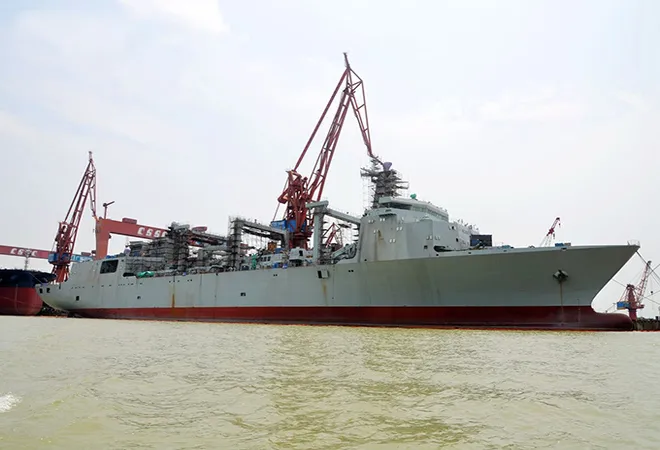
Any country with blue water navy dreams need carrier vessels (CVs) to pursue those dreams. And every CV that is in blue waters away from home requires replenishment of cargo and fuel. Sustained naval operations at far seas, especially of the aviation fleet, demand replenishment every 4-5 days, because it requires the CV to operate at maximum speeds for extended periods. Thus there is a strong need to have a replenishment vessel with comparable speeds to accompany the CV battle group (CVBG).
China’s initial deployment away from its shore was the anti-piracy missions to Gulf of Aden, which essentially were also used as goodwill visits to various countries in Asia, Africa and Europe. The extended deployment of these flotillas exposed the need for food, water, medicines and other essentials that couldn’t be met by Type 903/903As accompanying them. They had to depend on foreign ports for all the supplies. The obvious lesson learnt was the requirement of AOE type of vessel for underway replenishment.
China’s PLA Navy (PLAN) is building Type 901 "general supply vessel" at the China State Shipbuilding Corporation (CSSC) Offshore and Marine Engineering (Group) Company Limited (COMEC), Longxue shipyard in Guangzhou. The company was earlier known as Guangzhou Shipbuilding International, popularly known as GSI. The GE images of Longxue shipyard between September 2015 and February 2017 were studied to understand this new class of supply vessels.
Construction
The construction of China’s largest replenishment ship probably started somewhere in mid-2015, but was caught on satellite imagery only in September 2015.  And the first ship was launched in December 2015. But it started sea trials only in December 2016, suggesting the fitting out took almost a full year.
And the first ship was launched in December 2015. But it started sea trials only in December 2016, suggesting the fitting out took almost a full year.


The new class of replenishment ship has been constructed by COMEC at Longxue, opposite the new Bao’an International Airport, Shenzhen. The December 2016 satellite image above shows following details of the ship:
- Length -
- Beam - 32.5m.
- Gantries - Three and a half (half is at port side aft).
- Hose Rigs - Five, three on port and two on starboard, for liquid refuelling.
- Cargo Points - One on each side on central gantry for transhipment of dry cargo.
- Tonnage - Possibly 50000 Tons.
- Armament - Four possible H/PJ-13 and later possibly H/PJ-26 on front bow.
The ship is propelled by four QC-280 gas turbine engines. It has also most modern communication, ESM and ECM systems on board. The ship is complemented with a medical section and has two hangars in aft section.
Second unit
The second unit under construction was once again observed first on the satellite imagery of 12/9/16, recently released by GE. The size seems to be the same. It is being constructed in this image, before the sea trials of first unit have started, signifying that no changes in designs are expected. Recent photos suggest that it will be launched within a month or two.

Comparison
The PLAN classified this ship as a general supply vessel, but most of Chinese media compared the ship to US Navy’s Supply class TAO-20X AOE. An AOE – auxiliary oiler equipment combines characteristics of three ships AOR – replenishment, AE – equipment and AFS – fast combat stores. The US and other Western media were quick to point out that it was not an AOE but an AOR. Although comparable in size, speed and tonnage, the US Navy AOEs have four dry cargo posts, more than the Type 901.
While comparing the two countries’ AOEs, it is pertinent to note that the CVs of China are smaller in size than USN CVs, thus having less fuel & cargo requirements. This permits Chinese AOE to carry more ammunition and equipment.
The number of oilers for first line ships of PLAN is almost 1:15 but the same in case of USN is 1:5.

Challenges
Although the size of Chinese new class of replenishment ship provides capability to PLAN much to the surprise of everyone, but it comes with many challenges as mentioned below:
- Repairs: It is not known if this ship is equipped with repair facilities on board.
- Self Defence: The Type 901 has only four H/PJ-13s installed till now with a remote possibility of H/PJ-26 in front bow.
- Funds: The constraining factor for weapon systems on board seems to be availability of funds for the project.
- Numbers: The number of AOEs although complement the CV production, the oiler to first line ships ratio remains very low.
Future
The COMEC seems to have been contracted for the construction of four more ships of the class, although it is expected that the next two would be constructed only after the sea trials of at least the first unit are complete. The next two will in the most likelihood be Type 901A with most of the challenges addressed. The amazing construction speed of the Longxue shipyard suggests that one unit per year would be produced.
There are strong rumours afloat on the Chinese internet that the Type 901 ships will be named after fresh water lakes of Inner Mongolia – first unit #956 should be Hulun Hu and the second unit #957 could be Bei’er Hu to complement the sister ship.
Blue Navy dream
With the advent of PLAN’s Type 901 general supply vessel, China seems to be slowly closing the naval gap with the US Navy. The future PLAN bases will further increase the range of its CVBGs. Soon the forays of PLAN in the IOR will not only increase in numbers but also in its assertiveness. There is a strong need for India to bolster its naval strength in at least the Indian Ocean Region if not also in the Asia-Pacific.
The views expressed above belong to the author(s). ORF research and analyses now available on Telegram! Click here to access our curated content — blogs, longforms and interviews.




 And the first ship was launched in December 2015. But it started sea trials only in December 2016, suggesting the fitting out took almost a full year.
And the first ship was launched in December 2015. But it started sea trials only in December 2016, suggesting the fitting out took almost a full year.



 PREV
PREV


